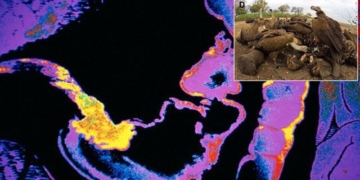The immune system consists of two types of cells, T and B. T cells are often highlighted in studies related to Covid-19 due to their ability to remember and combat the development of SARS-CoV-2 virus.
There are approximately three billion B cells circulating in the blood, each cell coated with highly adhesive antibodies designed to fit the antigens of diseases that it may never encounter, possibly even diseases that do not exist. B cells spend most of their short lifespan moving around until they fortuitously encounter the corresponding antigen characteristic of pathogens (such as bacteria, viruses, fungi, or unfamiliar parasites).

Illustration of T cells fighting against foreign cells invading the body. (Source: Medial News).
If the antigen that we encounter fortuitously matches the specific antigen receptor of an antibody from a B cell (the antibody tightly binds to the B cell like a clove on a Christmas ham), that B cell immediately becomes active, producing clones of itself, with daughter cells that are identical and equipped with “matching” antibodies.
Within 12 hours, that B cell can produce 20,000 copies of itself, a process that continues over the course of a week. Each new member born from the cloned army of B cells becomes a new factory, solely producing antibodies against that specific type of pathogen.
Now it’s time to attack. The antibodies on the surface of the B cells launch out like guided missiles at a rate of 2,000 antibodies per second. Each of these antibody missiles has only one target: the foreign antigen characteristic on those strange cells. They see nothing else. Antibodies identify and bind to, clustering around the target like burrs on a dog’s fur. This not only halts the pathogenic cells, but it also acts as a flashing neon sign drawing the attention of nearby macrophages, luring them to a free meal.
They seem to stimulate the appetite of “natural scavengers” (a process known as opsonization, derived from the German term “preparing to eat”). The invading foreign cells become tightly adhered and are then engulfed.
This is a graceful and wonderfully sophisticated defense system, enhancing the response to a new disease in about a week. Once the threat has passed, most of the B cell army dies off, but a contingent remains, remembering what happened, ready to return to battle when that threat reappears.
This is immunity.
B and T cells look almost identical under a light microscope (one reason why T cells were not discovered until the 20th century was nearly over). Like B cells, T cells detect foreign antigens and generate a cloned army to attack them. However, T cells recognize and destroy pathogenic cells in a completely different way.
T cells lock onto the exposed foreign antigens and destroy the pathogenic cells as their specialty. After the attackers are eliminated, most of the cloned immune army dies off, but some remain to remember. If that attacker returns, it won’t take a week to create a new army for the defense system. The body is ready.


















































